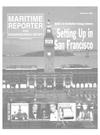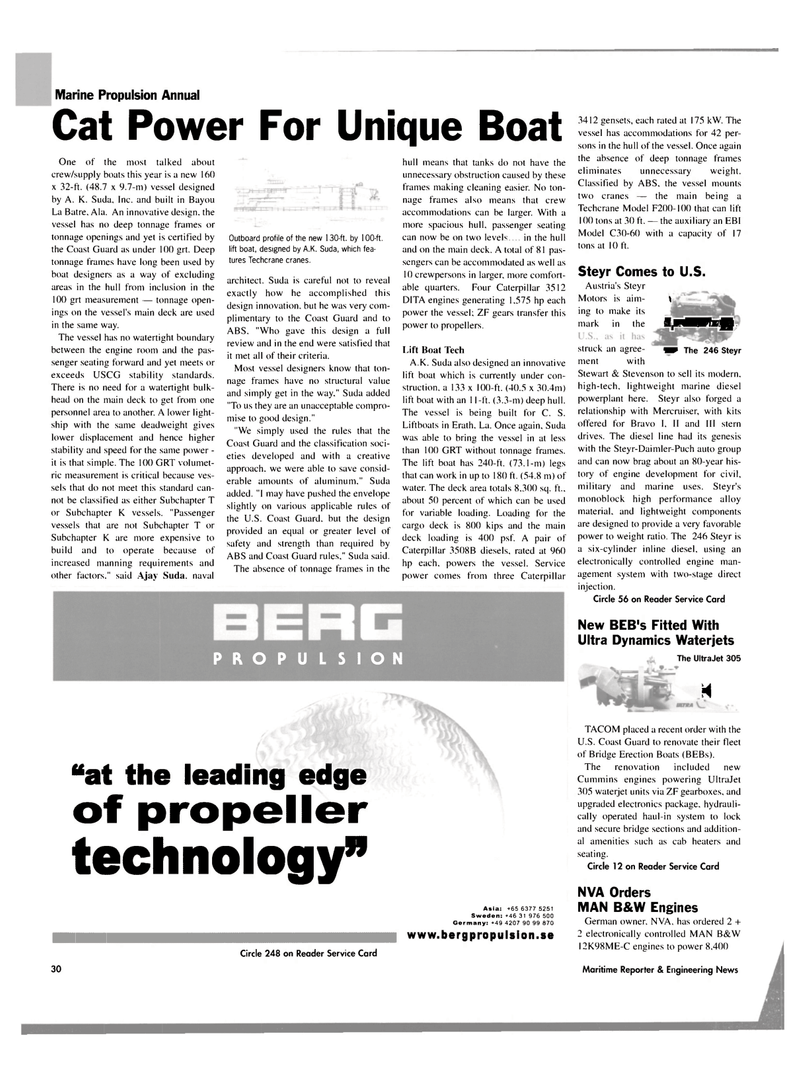
Page 30: of Maritime Reporter Magazine (September 2003)
Read this page in Pdf, Flash or Html5 edition of September 2003 Maritime Reporter Magazine
Marine Propulsion Annual
Cat Power For Unique Boat
One of the most talked about crew/supply boats this year is a new 160 x 32-ft. (48.7 x 9.7-m) vessel designed by A. K. Suda, Inc. and built in Bayou
La Batre, Ala. An innovative design, the vessel has no deep tonnage frames or tonnage openings and yet is certified by the Coast Guard as under 100 grt. Deep tonnage frames have long been used by boat designers as a way of excluding areas in the hull from inclusion in the 100 grt measurement — tonnage open- ings on the vessel's main deck are used in the same way.
The vessel has no watertight boundary between the engine room and the pas- senger seating forward and yet meets or exceeds USCG stability standards.
There is no need for a watertight bulk- head on the main deck to get from one personnel area to another. A lower light- ship with the same deadweight gives lower displacement and hence higher stability and speed for the same power - it is that simple. The 100 GRT volumet- ric measurement is critical because ves- sels that do not meet this standard can- not be classified as either Subchapter T or Subchapter K vessels. "Passenger vessels that are not Subchapter T or
Subchapter K are more expensive to build and to operate because of increased manning requirements and other factors," said Ajay Suda. naval
Outboard profile of the new 130-ft. by 100-ft. lift boat, designed by A.K. Suda, which fea- tures Techcrane cranes. architect. Suda is careful not to reveal exactly how he accomplished this design innovation, but he was very com- plimentary to the Coast Guard and to
ABS. "Who gave this design a full review and in the end were satisfied that it met all of their criteria.
Most vessel designers know that ton- nage frames have no structural value and simply get in the way," Suda added "To us they are an unacceptable compro- mise to good design." "We simply used the rules that the
Coast Guard and the classification soci- eties developed and with a creative approach, we were able to save consid- erable amounts of aluminum." Suda added. "I may have pushed the envelope slightly on various applicable rules of the U.S. Coast Guard, but the design provided an equal or greater level of safety and strength than required by
ABS and Coast Guard rules," Suda said.
The absence of tonnage frames in the hull means that tanks do not have the unnecessary obstruction caused by these frames making cleaning easier. No ton- nage frames also means that crew accommodations can be larger. With a more spacious hull, passenger seating can now be on two levels.... in the hull and on the main deck. A total of 81 pas- sengers can be accommodated as well as 10 crewpersons in larger, more comfort- able quarters. Four Caterpillar 3512
DITA engines generating 1.575 hp each power the vessel; ZF gears transfer this power to propellers.
Lift Boat Tech
A.K. Suda also designed an innovative lift boat which is currently under con- struction. a 133 x 100-ft. (40.5 x 30.4m) lift boat with an 11-ft. (3.3-m) deep hull.
The vessel is being built for C. S.
Liftboats in Erath. La. Once again, Suda was able to bring the vessel in at less than 100 GRT without tonnage frames.
The lift boat has 240-ft. (73.1-m) legs that can work in up to 180 ft. (54.8 m) of water. The deck area totals 8,300 sq. ft., about 50 percent of which can be used for variable loading. Loading for the cargo deck is 800 kips and the main deck loading is 400 psf. A pair of
Caterpillar 3508B diesels, rated at 960 hp each, powers the vessel. Service power comes from three Caterpillar 3412 gensets, each rated at 175 kW. The vessel has accommodations for 42 per- sons in the hull of the vessel. Once again the absence of deep tonnage frames eliminates unnecessary weight.
Classified by ABS, the vessel mounts two cranes — the main being a
Techcrane Model F200-100 that can lift 100 tons at 30 ft. — the auxiliary an EBI
Model C30-60 with a capacity of 17 tons at 10 ft.
Steyr Comes to U.S.
Austria's Steyr
Motors is aim- \ ing to make its mark in the 5 ^WMjWK.j^i. struck an agree- The 246 Steyr ment with
Stewart & Stevenson to sell its modern, high-tech, lightweight marine diesel powerplant here. Steyr also forged a relationship with Mercruiser, with kits offered for Bravo I, II and III stern drives. The diesel line had its genesis with the Steyr-Daimler-Puch auto group and can now brag about an 80-year his- tory of engine development for civil, military and marine uses. Steyr's monoblock high performance alloy material, and lightweight components are designed to provide a very favorable power to weight ratio. The 246 Steyr is a six-cylinder inline diesel, using an electronically controlled engine man- agement system with two-stage direct injection.
Circle 56 on Reader Service Card
New BEB's Fitted With
Ultra Dynamics Waterjets
TACOM placed a recent order with the
U.S. Coast Guard to renovate their fleet of Bridge Erection Boats (BEBs).
The renovation included new
Cummins engines powering UltraJet 305 waterjet units via ZF gearboxes, and upgraded electronics package, hydrauli- cally operated haul-in system to lock and secure bridge sections and addition- al amenities such as cab heaters and seating.
Circle 12 on Reader Service Card
NVA Orders
MAN B&W Engines
German owner. NVA, has ordered 2 + 2 electronically controlled MAN B&W 12K98ME-C engines to power 8.400
PROPULSION "at the leading edge of propeller technology"
Asia: +65 6377 5251
Sweden: +46 31 976 500
Germany: +49 4207 90 99 870 ^//gg/ggg/g/gggg^^ www.bergpropulsion.se
Circle 248 on Reader Service Card
The UltraJet 305
H 30 Maritime Reporter & Engineering News

 29
29

 31
31
